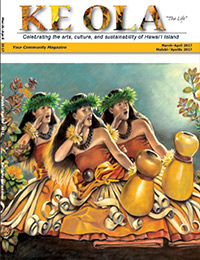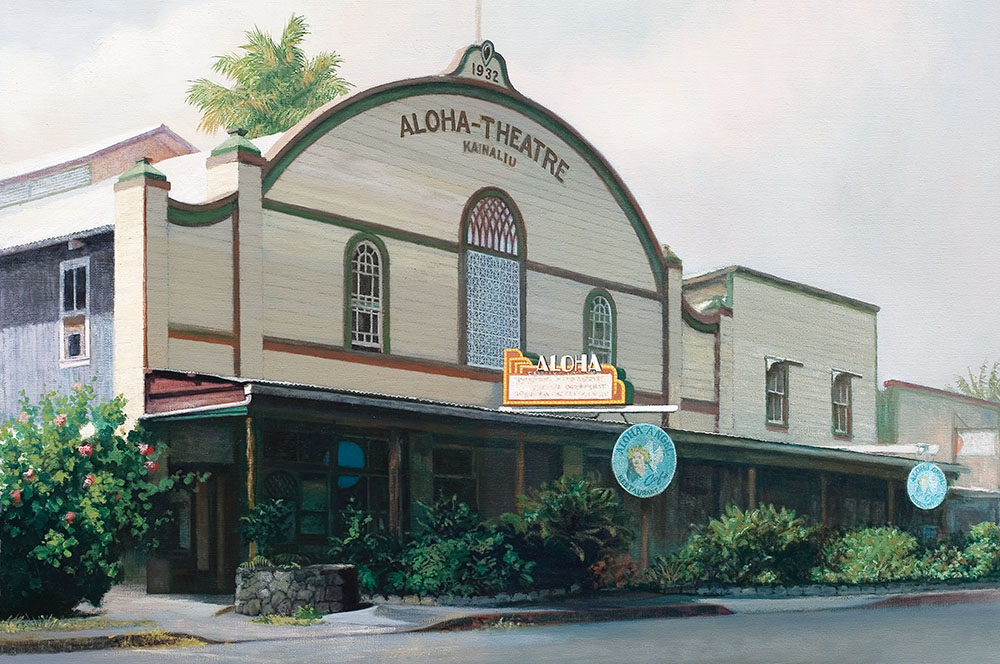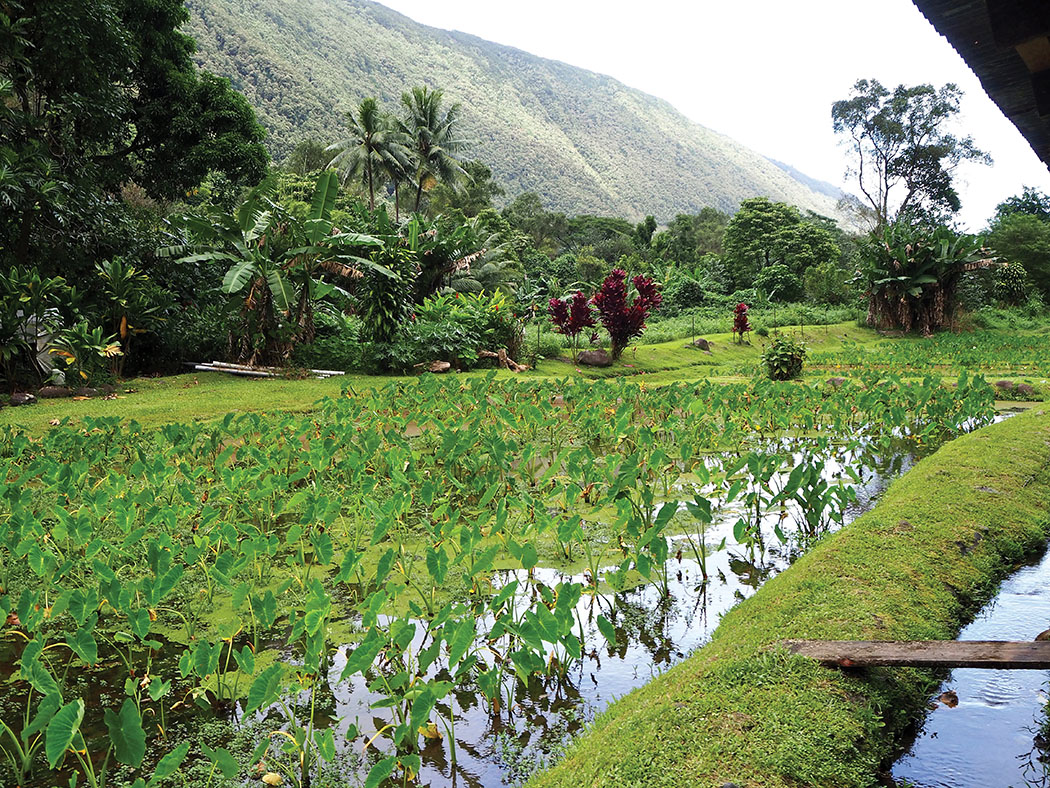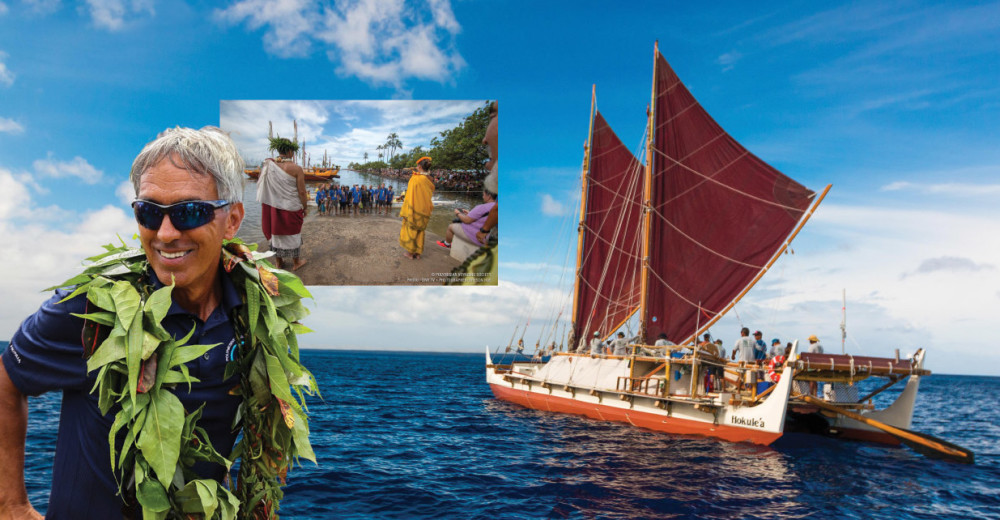Implements of Hula
By Leilehua Yuen
 From ancient times, Hawaiian people have had a love of music and rhythm. This love was expressed through oli (chant), mele (song), and hula (dance).
From ancient times, Hawaiian people have had a love of music and rhythm. This love was expressed through oli (chant), mele (song), and hula (dance).
While many early visitors to the Hawaiian Islands were not trained in music, and had limited understanding of musical concepts, a few, such as Capt. James King (who accompanied Capt. Cook), and Capts. Burney and Phillips of England’s Marines, had more sophisticated musical training and noted that Hawaiian people were skilled at singing in harmony and accompanying themselves on a variety of instruments. They also realized the Hawaiian musical scale included many notes which fell between the notes on a Western scale.

on page 23.
In the previous two centuries, Hawaiian music often was described by Westerners as “weird” and “barbaric.” Since the 1970’s Hawaiian Cultural Renaissance, Hawaiian music has been gaining global recognition for its depth and beauty.
Often, the traditional instruments of ancient times were very simple. Natural items such as sticks and stones might be used as they were found, or beautifully cleaned and polished. Examples of these are the ‘ili‘ili (water-worn river or beach pebbles) used as castanets, and kāla‘au (rhythm sticks).
Other instruments were finely crafted with great care. The pahu, or great temple drum used in formal hula, was made by master craftsmen who were experts in the art of carving. The ‘ulī‘ulī, a special kind of rattle used in the hula, uses the skills of carving, weaving, and feather working to create a beautiful instrument that can sound like the tropical rains.
Probably the most dramatic of instruments one will see on the hula stage is the great pahu drum. The oldest writings call the large coconut-trunk drum with a sharkskin head “kā‘eke” or “kā‘eke‘eke.” This drum has its heritage in the great temple drums that resounded for important ceremonies such as the start of a war or the birth of a chief. They are usually made from the trunk of a coconut tree with a diaphragm carved about 1/3 up from the bottom. They vary greatly in size. Traditionally, the drumhead is shark skin. In modern times, rawhide is often used. Because of its heritage, it is associated with strict protocols. Hula for the pahu tends to be quite formal.
The pūniu, a small knee drum often seen in hula, is made from half a coconut shell. The drumhead is traditionally from the tough skin of the kala (Acanthurus unicornis) fish. The lacings run through the edge of the skin and are attached to a cordage ring at the base of the drum, to which are also attached ties used to secure the drum to the right thigh of the player. To play it, the musician holds a kā, a rope striker, in the right hand.
The ipu heke, double gourd hula drum, is unique to Hawai‘i. There is no evidence of it having developed anywhere else. It is fashioned from two gourds which are attached to each other at the neck. The upper portion has a hole or “mouth” at the top of the drum. It is struck on a pale (pronounced PAH-lay, a protective pad) on the floor, and with the hand, to create the distinctive rhythmic motifs associated with traditional hula. The ipu hula, a smaller drum made from a single gourd, is often used by the dancer.
Kā‘eke‘eke, or pahūpahū, bamboo pipe drums, are fashioned by selecting an appropriate piece of bamboo, often Schizostachyum glaucifolium. From the top, nodes are punched out with a long stick, allowing the full length of the bamboo to resonate. Kā‘eke‘eke vary in length from a couple of feet to over two yards. The longer the length, the deeper the tone. They generally are used in sets of two, one held vertically in each hand. The bases with the nodes are struck on a stone or other hard surface covered by a thin mat, creating a resonant drumming. The bamboo is often tuned by cutting the lengths to play specific notes.
‘Ili‘ili and kāla‘au are the two most simple, and the two most commonly seen, striking implements. Two ‘ili‘ili are held in each hand in such a way that they may be clicked against each other to make a variety of percussive clicks. Sometimes they are compared to castanettes.
Kāla‘au are used in pairs, and come in different sizes. Most common are two sticks, around 12 to 16 inches, of equal length. One long stick paired with a shorter one for striking it has become more widely used in recent times. Sometimes the longer stick may be carved with ridges to produce a clicking or ringing tone when the shorter stick is rubbed along it. Short spears or javelins are sometimes used in place of the longer stick.
The ‘ukēkē is a stringed instrument, generally about two feet long or a little under. It is made from a flattened piece of hardwood, such as kauila (Alphitonia ponderosa). A flange at one end and slits at the other hold the strings. One, two, or occasionally three strings are attached to the ends of the ‘ukēkē and tightened to bend the wood enough to tune and play them. The tone is buzzy and light. The notched end is placed between the lips and the mouth of the musician acts as a resonating chamber. The ‘ukēkē was used to accompany hula and chant, as well as in extemporaneous courting melodies.
There are a number of ways to make a nī‘au kani, which sounds something like a kazoo or musical comb. The simplest uses a coconut leaflet. A section, about 4 to 6 inches long, is taken from the leaflet. A fingernail, needle, or other sharp object is used to pierce and slice the leaf away from the midrib, leaving about an inch on each end to hold the leaf. The leaf is then held to the mouth, outer (convex) side toward the mouth with the midrib between the lips. By singing or talking through the leaflet, a kazoo-like sound can be made which gives a buzzing quality to the voice.
The ‘ohe hano ihu is a traditional Hawaiian flute made from bamboo (Schizostachyum glaucifolium). It is considered a sweetheart’s instrument. It is not a loud instrument; rather, the tone is intended to be soft and sweet. Traditionally, it is not played in concert for a large audience, but played in a quiet place for someone special. It is also used in hula, as well as in courting. The spacing of the holes and the length of the flute were entirely a matter of personal taste, determined, presumably by what the suitor believed would please the object of his affections. He would then carefully sand the flute and burnish it with oil. Each flute, and its song, was as unique as the person who crafted it.
The hoehoe is a simple bamboo tube, open at both ends or closed at the bottom end. It is held vertically, and the top end is blown across, much like blowing across the mouth of a bottle. The name means, “a plaintive prolonged sound.” Like the ‘ohe hano ihu, it is ideally made from bamboo (Schizostachyum glaucifolium).
The traditional Hawaiian gourd whistle was played primarily for amusement, and by sweethearts. It is made from a small gourd (Lagenaria siceraria) or a kamani (Calophyllum inophyllum) seed. Like the ‘ohe hano ihu, it is played with the nose. The gourd or seed is drilled with a hole for the nose and one, two, or three additional pitch holes. The seeds and or meats are removed and then it can be played.
The oeoe, or Hawaiian bullroarer, is made from the shell of a coconut. The best tone comes from old shells which are light and thin. A hole, about one-half to one inch diameter, is carved into the end near the eyes. Strings are threaded through the eyes and drawn up to a long string used to swing the oeoe in circles. The sound is like the wind on a mountaintop. Some feel it is a children’s toy, but others consider it to be an instrument which represents the wind.
The pū, or ‘olē, is the classic shell trumpet of Polynesia, used to announce the arrival of chief, ceremonies, and important events. It also is used as a signaling device on canoes. Generally made from Charonia tritonis or Cassis cornuta. A hole is made at the apex of the shell and used to blow, trumpet-like into the body which acts as a resonating chamber. At the opening of the Merrie Monarch Hula Festival, the Royal Court is preceded by attendants blowing the pū.
Less well known than the pū, the pū ‘ohe serves the same purposes and is equally important. While the helmet shell pū and the conch shell pū were more difficult to acquire and prized by the chiefs for their tone, volume, and beauty, the pū ‘ohe was accessible to everyone. A signaling device for sailors at sea and hunters in the forest, it also announced ceremonies and called people home from the fields. Used by all levels of society, this simple trumpet is made from just one section of bamboo. One end is open, and the other end is closed by the node. The node has a hole bored in it and is smoothed to fashion the simple mouthpiece through which the player blows.
The pū lā‘ī, leaf whistle, is usually made from a rolled leaf of tī or ginger. It is primarily made by children as a toy, but hunters and hikers also sometimes use them as signaling whistles. The leaf is split longitudinally and the midrib removed. The leaf is then folded over, underside (dull side) outermost, with the tip and the petiole ends touching each other. Holding the fold by the margin of the leaf, the folded leaf is wrapped around the finger to form a cylinder. Looking through the cylinder, two layers of leaf bisect it. The leaf cylinder is held in the fingers and placed just enough between the lips that it may be flattened somewhat when the lips are placed into a rigid line and air blown through the pū lā‘ī. Careful adjustment will allow air to cross the bisecting portion of leaf and vibrate it, creating a piercing whistle.
From simple whistles to finely crafted drums, the music of Hawai‘i is enhanced by a variety of implements. Not only do they add to the music, incorporated into choreography where appropriate, they add to the texture and beauty of the hula. As the ‘ōlelo no‘eau (traditional proverb) says, I le‘a ka hula i ka ho‘opa‘a, “The hula is pleasing because of the drummer.”
Bibliography
Buck, Te Rangi Hiroa Peter; Arts and Crafts of Hawai‘i
Craig, Dr. Robert D; Dictionary of Polynesian Mythology
Beamer, Winona; Nā Mele Hula
Beckwith, Martha: The Hawaiian Romance of Laieikawai
Gutmanis,June; Na Pule Kahiko, Ancient Hawaiian Prayers
Thrum,Thomas G; Hawaiian Almanac and Annual for 1902
Westervelt, WD; Hawaiian Legends of Volcanoes
Beamer, Winona; Interviews, 1997-2007
Josiah, Manu; Interviews, 2005-2015
Natividad, Anthony; Interview, 2011
Contact writer Leilehua Yuen: kumuleimanu@gmail.com


